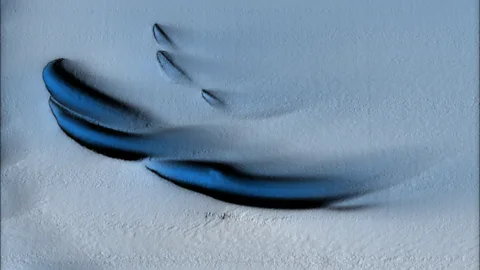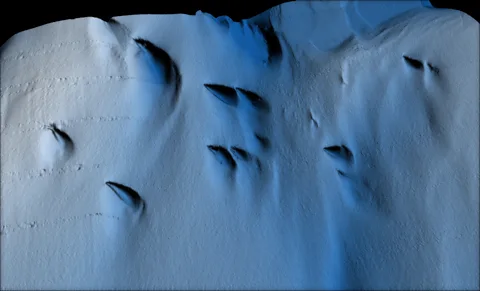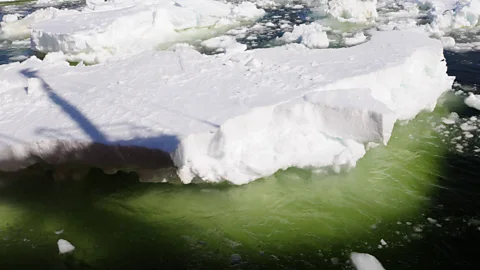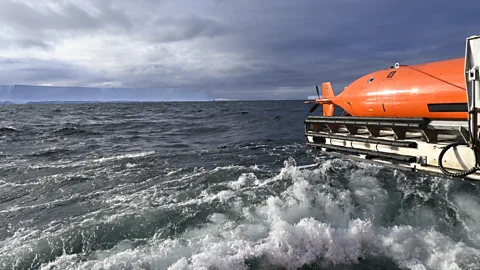 Filip Stedt/University of Gothenburg
Filip Stedt/University of GothenburgWhen scientists peered beneath one of Antarctica’s floating ice shelves, they were surprised to find an upside-down landscape of peaks, valleys and plateaus.
“We were surprised – we had to double check it was real,” says Anna Wåhlin, professor of physical oceanography at the University of Gothenburg, Sweden. “But we realised, it really does look like this – there are these shapes. There is a landscape of ice down there we had no idea about before,” she says.
In 2022, an international team of scientists led by Wåhlin lowered an unmanned submersible underneath 350m (1,150ft) thick Antarctic ice. For 27 days, it travelled over 1,000km (621miles) back and forth under the Dotson Ice Shelf in West Antarctica, scanning the ice above it with an advanced sonar. The result was the very first map of the underside of an ice shelf – and the discovery of an otherworldly ice-scape – which Wåhlin likens to seeing the dark side of the moon for the first time.
The never before seen “swirls and scoops” map the meltwater’s journey as it flows beneath the ice, giving us a new understanding of how the ocean melts Antarctica’s ice – and how its fate could affect us all.
“The West Antarctic Ice Sheet (WAIS) is what we call everything to the west of the Transantarctic Mountains,” says Wåhlin. “It’s a massive amount of ice – it would be dramatic if it were to end up in the ocean,” she says.
 Anders Sjövall
Anders SjövallWhile world leaders discussed the potentially devastating impacts of sea level rise at COP29 in Baku, Azerbaijan in November 2024, some 16,000km (9,904 miles) away, on the very bottom of the Earth, scientists were busy studying Antarctica’s ice shelves. They hope that by furthering understanding of how sea ice melts, we can better predict how its fate could affect cities worldwide.
“Over the last 30 years Thwaites’ [melt rate] has pretty much doubled – and we know that’s accelerating. We think it’s going to keep accelerating, and at some point it could get much quicker,” says Alex Brisbourne, a glacier geophysicist at the British Antarctic Survey (BAS). “We are really worried about how quickly Antarctica is going to put all this additional ice into the ocean. You think about all the big coastal cities – London, New York,” he says.
“If you melt all the ice in Thwaites, you’re going to raise sea levels by 65cm (26 inches) – that’s the mean sea level rise across the entire globe,” says Brisbourne.
 Filip Stedt/ University of Gothenburg
Filip Stedt/ University of GothenburgHowever, very little is known about Antarctica’s ice shelves, says Wåhlin, as access can be tricky. “We don’t have much data from inside the cavities, and not much at all from the ocean-ice interface.” And in 2022, when Wåhlin’s team failed to reach the Thwaites Ice Shelf – as sea ice and icebergs blocked their route – they instead conducted their research at Dotson.
The team’s uncrewed submersible, named “Ran”, was programmed while on the ship, with “hundreds of lines of commands telling it what to do, where to go, what sensors to switch on”, explains Wåhlin. And when team from the International Thwaites Glacier Collaboration (ITGC) watched Ran sink out of view beneath the ice shelf, “we were really nervous”, she says.
But when the submersible returned with detailed images of the underside of the ice shelf, Wåhlin was surprised at what she saw; peaks, valleys, plateaus and teardrop-shaped formations.
Ice can melt at different rates along the same ice shelf, depending on the movement of the water, and Ran’s images revealed the basal topography of the Dotson Ice Shelf varies significantly from east to west. In the east the ice is thick and melts slowly. “That’s where we saw the biggest surprise,” says Wåhlin. “It looked like the Grand Canyon. There were plateaus and swirly patterns melted into the ice.”
Moving towards the centre of the ice shelf, the images showed terraced features. Meanwhile in the west, the ice was noticeably thinner with smooth features, indicating faster-moving currents and so higher melt rates.
“[Here] the surface was quite smooth, and you could clearly see streaks in the ice that looked like erosion from the water moving beneath it,” says Wåhlin. “What surprised us, in the western part, were these scoops of ice. It was as if a giant had taken an ice cream scoop and scooped it out. We saw many – they were everywhere – 75 I think we counted, shaped like teardrops or blue mussels. They were up to 300m (984ft) long – or even longer – and their vertical extent was up to 20m (66ft).”
The images also revealed vertical fractures that extended upwards through the ice shelf. “All over the ice shelf we saw these,” says Wåhlin. “We expected that because they are visible from space – but the surprising thing was what they looked like from below.”
 Filip Stedt/ University of Gothenburg
Filip Stedt/ University of GothenburgThe base of the fractures, explains Wåhlin, were not smooth like the team expected – but also had scoops in them running almost at right angles to the main fracture. The older the fractures were – the oldest being about 40 years according to satellite data – the more scoops they had. “You could clearly see that they had been eroded. They were rounded at the base,” says Wåhlin.
Conversely, the younger fractures – ones that were two- to three-years-old, says Wåhlin – had no visible scoops and abrupt edges. “We had no idea that you would see such a clear difference between the old and the new fractures,” says Wåhlin.
“It’s so far away. It takes forever to get there [to Antarctica],” says Patricia Yager, an oceanographer at the University of Georgia, has visited Antarctica four times to carry out her research on the links between marine ecosystems and climate change. “When the icebreaker breaks the ice and it flips upside down, it’s covered with beautiful golden algae, and krill feeding on the algae. It’s colourful and full of life, like a coral reef.” This is no biological desert, says Yager.
 Patricia Yager
Patricia YagerSpring melting of seasonal sea ice usually stabilises the ocean surface layer, helping phytoplankton to stay in the sunlit zone where they can photosynthesise and bloom as long as there are adequate nutrients. However, the increase in melting ice is causing a “significant” shift, according to research by Portuguese and Brazilian scientists. This raises questions, they say, about what the consequences might be for global carbon sequestration and Antarctic food webs in the future – if the vital components of nutrient supply, light exposure and stability from sea ice melt do not coincide.
“This place doesn’t seem like it’s touched by humans,” says Yager, “but it’s hugely touched”. A decade after her first visit, Yager returned to find “much more fresh water” dumped into the ocean as the ice melts ever faster. “The salinity of the ocean was very much fresher than it had been,” she says. “There’s all this warm water invading the upper couple of 100 metres of the ocean. And that’s kind of shocking. It makes it harder for the sea ice to form, because the sea ice depends on the water being cold enough to freeze,” says Yager. “There are places where the ice isn’t coming back as early as it should in the fall, and places where it disappears sooner than it should in the spring.”
If climate change continues to increase meltwater and iron availability in the Amundsen Sea polynya, phytoplankton will continue bloom in the short term, says Yager. But if left unchecked, it could spell the end for sea ice altogether. If the ice disappears, the delicate layers of the sea will blend together, and the wind will mix phytoplankton down to where they can no longer bloom, says Yager. Then, she adds, the extra iron from glacial meltwater won’t help.
In 2024, Wåhlin’s team returned to Antarctica to continue mapping the underside of the Dotson Ice Shelf – but after just two dives, Ran disappeared into the darkness, and was lost without a trace.
“The difficulty here is in the programming,” says Wåhlin. “You have to think about all the scenarios – what it [the unmanned submersible] could possibly encounter, and how it will react if it encounters something that you haven’t anticipated. For example, it checks all the time: ‘how close am I to the seabed, and how close am I to the ice above’.”
 Li Ling/ KTH Royal Institute of Technology
Li Ling/ KTH Royal Institute of TechnologyWåhlin’s theory is that the submersible may have run into some curious marine mammals, causing it to change course so as to avoid collision. “We did notice many Weddell seals in the area,” she says. If seals were to circle the vehicle, she adds, a new manoeuvre would be triggered, and another and another. “Eventually it could get stuck. Then it would shut down all systems and stop the propeller to try and conserve energy. If that were to happen under the ice, it wouldn’t come out again.”
But questions remain unanswered about the structures the submersible found, too. The researchers saw patterns on the base of the ice shelf they were not expecting – perhaps formed by flowing water under the influence of Earth’s rotation, says Wåhlin. Current models can’t explain these discoveries, she says, and there is a wealth of processes left to discover in future research missions under the glaciers.
“We hope to be able to replace Ran and continue this important work,” says Wåhlin. “I would love to go back and look again at the patterns – to see how they change over the years.”
